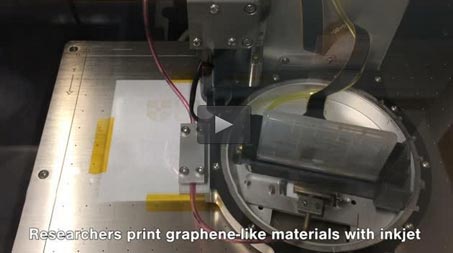Researchers printed graphene-like materials with inkjet

Researchers team has developed inks made of graphene-like materials for inkjet printing. New black phosphorous inks are compatible with conventional inkjet printing techniques for optoelectronics and photonics. (Video) Credit: University of Cambridge
Since the discovery of the Nobel Prize winning material graphene, many new nanomaterials promise to deliver exciting new photonic and optoelectronic technologies. Black phosphorous is a particularly interesting post-graphene nanomaterial for next generation photonic and optoelectronic devices. Yet despite remarkable performance in the lab, practical real-world exploitation of this material has been hindered by complex material fabrication and its poor environmental stability.
“Our inkjet printing demonstration makes possible for the first time the scalable mass fabrication of black phosphorous based photonic and optoelectronic devices with long-term stability necessary for a wide range of industrial applications”, tells Professor Zhipei Sun at Aalto University in Finland.
Scientists optimized the chemical composition to achieve a stable ink through the balance of complex and competing fluidic effects. This enabled the production of new functional photonic and optoelectronic devices by inkjet printing with excellent print quality and uniformity – just like the printing of intricate graphics or photographs on paper.
The researchers' work demonstrated the benefits of their novel technique by inkjet printing devices that take advantage of the properties of black phosphorous, not least its semiconducting bandgap that can be readily varied by engineering the number of atomic layers and can cover the visible and near-infrared region of the electromagnetic spectrum.
The researchers also demonstrated printed black phosphorous based nonlinear optical devices that can be easily inserted into lasers to act as ultra-quick optical shutters, converting a continuous beam of laser radiation into a repetitive series of very short bursts of light suited for industrial and medical applications, such as machining, imaging and sensing. In the study, black phosphorous was also able to act as an efficient and highly-responsive detector of light, extending the wavelength range over which conventional silicon-based photodetectors can operate.
Importantly, the researchers showed that the black phosphorous ink can be seamlessly integrated with existing complementary metal-oxide-semiconductor (CMOS) technologies, while the inkjet printing technique developed offering the prospect of supporting the fabrication of so-called heterostructured materials that aim to capitalize on the benefits of distinct, yet complementary properties of multiple nanomaterial layers through controlled fabrication.
The new ink was developed by an interdisciplinary team of international researchers at Aalto University, University of Cambridge (UK), Imperial College London (UK) and Beihang University (China). The research was supported by the Academy of Finland, Tekes – the Finnish Funding Agency for Innovation, Nokia Foundation and European Commission.
Media Contact
More Information:
http://www.aalto.fi/en/current/news/2017-08-17-005/All latest news from the category: Materials Sciences
Materials management deals with the research, development, manufacturing and processing of raw and industrial materials. Key aspects here are biological and medical issues, which play an increasingly important role in this field.
innovations-report offers in-depth articles related to the development and application of materials and the structure and properties of new materials.
Newest articles

NASA: Mystery of life’s handedness deepens
The mystery of why life uses molecules with specific orientations has deepened with a NASA-funded discovery that RNA — a key molecule thought to have potentially held the instructions for…

What are the effects of historic lithium mining on water quality?
Study reveals low levels of common contaminants but high levels of other elements in waters associated with an abandoned lithium mine. Lithium ore and mining waste from a historic lithium…

Quantum-inspired design boosts efficiency of heat-to-electricity conversion
Rice engineers take unconventional route to improving thermophotovoltaic systems. Researchers at Rice University have found a new way to improve a key element of thermophotovoltaic (TPV) systems, which convert heat…



